
Throughout the year, special events lead to changes in Internet traffic. We observed this with Thanksgiving in the US last week, where traffic dipped, and during periods like Black Friday (November 24, 2023) and Cyber Monday (November 27, 2023), where traffic spiked.
But how significant are these Cyber Week days on the Internet? Is it a global phenomenon? Does e-commerce interest peak on Black Friday or Cyber Monday, and are attacks increasing during this time? These questions are important to retailers and stakeholders around the world. At Cloudflare, we manage substantial traffic for our customers, which gives us a unique vantage from which to analyze traffic and attack patterns across large swaths of the Internet.
As we'll explore next, we observed varying trends. From a global perspective, there was a clear Internet traffic winner: Cyber Monday was the highest overall traffic day of 2023 (as it was for 2022), followed by Black Friday, and then Monday, November 21 from the same week. But zooming in, this pattern didn’t hold in some countries.
For this analysis, we examined anonymized samples of HTTP requests crossing our network, as well as DNS queries. Cloudflare's global data shows that peak request traffic occurred on Cyber Monday, and that recent weeks have generally been the year’s busiest. Here are some notable figures:
- Cloudflare processed a peak of 80 million HTTP requests per second at 16:10 UTC on November 27.
- The peak hour of 16:00 UTC saw more than 230 billion hourly requests.
- Cloudflare powered around 4 trillion daily requests on Cyber Monday (with blocked attacks comprising around 5% of all traffic), a figure only approached by Black Friday, which saw 3.86 trillion requests.
- There was a 27% increase in HTTP requests on Cyber Monday 2023 (November 27) as compared to Cyber Monday 2022 (November 28).
What about DNS queries?
- Aggregated from our 1.1.1.1 resolver showed that Cyber Monday 2023 experienced a peak of 1.68 trillion queries per day, with 22 million queries per second around 15:00 UTC. Of these DNS queries, 15% were encrypted (HTTPS and TLS). Back in August, the peak was at 1.35 trillion queries per day, marking a 24% increase.
- Traffic to our authoritative DNS servers also peaked on Cyber Monday, with 811 billion daily queries and a peak of 9.4 million queries per second around 15:00 UTC.
- So, during Cyber Monday, we saw a combined peak of over 100 million requests and queries per second across all Cloudflare services at around 16:00 UTC (November 27).
Black Friday week Internet traffic daily ranking
These numbers and trends are consistent with what we observed in 2022 and previous years, where traffic peaks in late November but usually drops in December. Here's a snapshot of global human Internet traffic this year (bot traffic shows a similar pattern).
Worldwide. Most popular Internet traffic days
- Cyber Monday, November 27
- Black Friday, November 24
- Monday, November 21
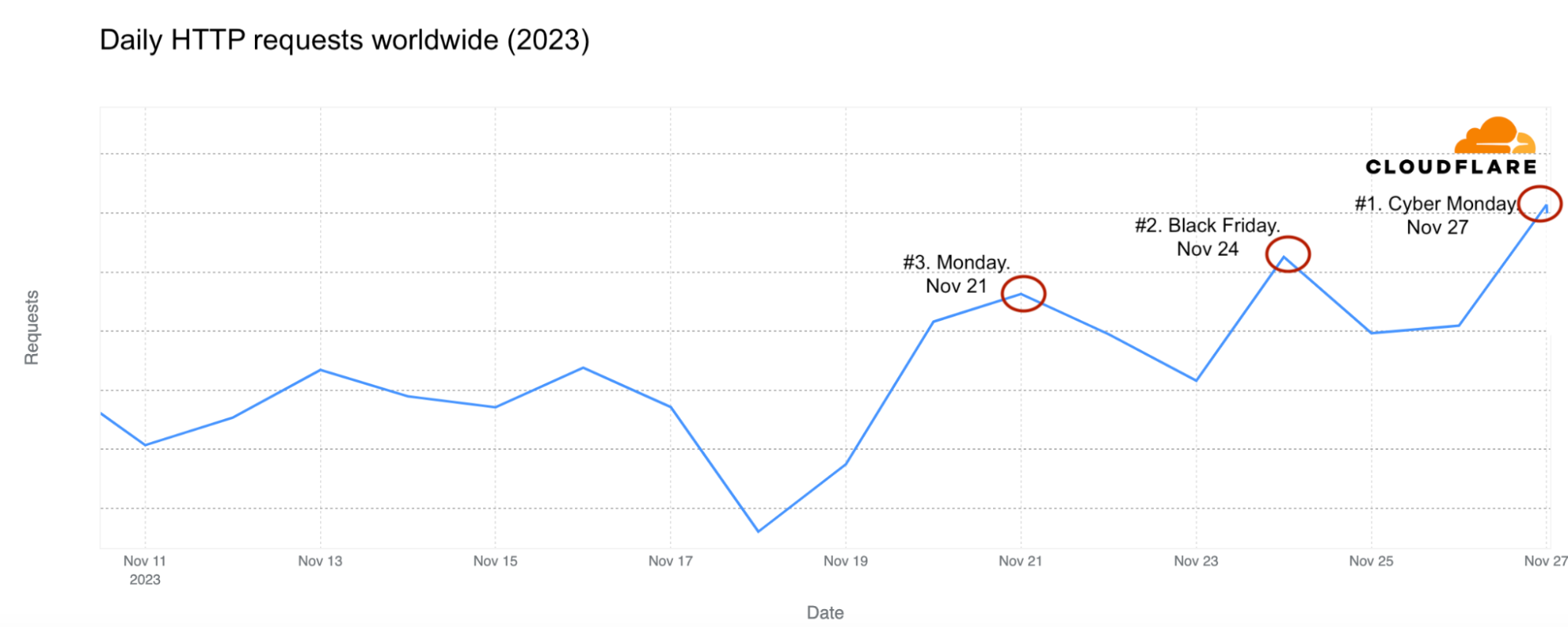
From the US perspective, the ranking is similar, with Saturday, November 25, the day after Black Friday, ranking as the third busiest day for Internet traffic.
US. Most popular Internet traffic days
- Cyber Monday, November 27
- Black Friday, November 24
- Saturday, November 25
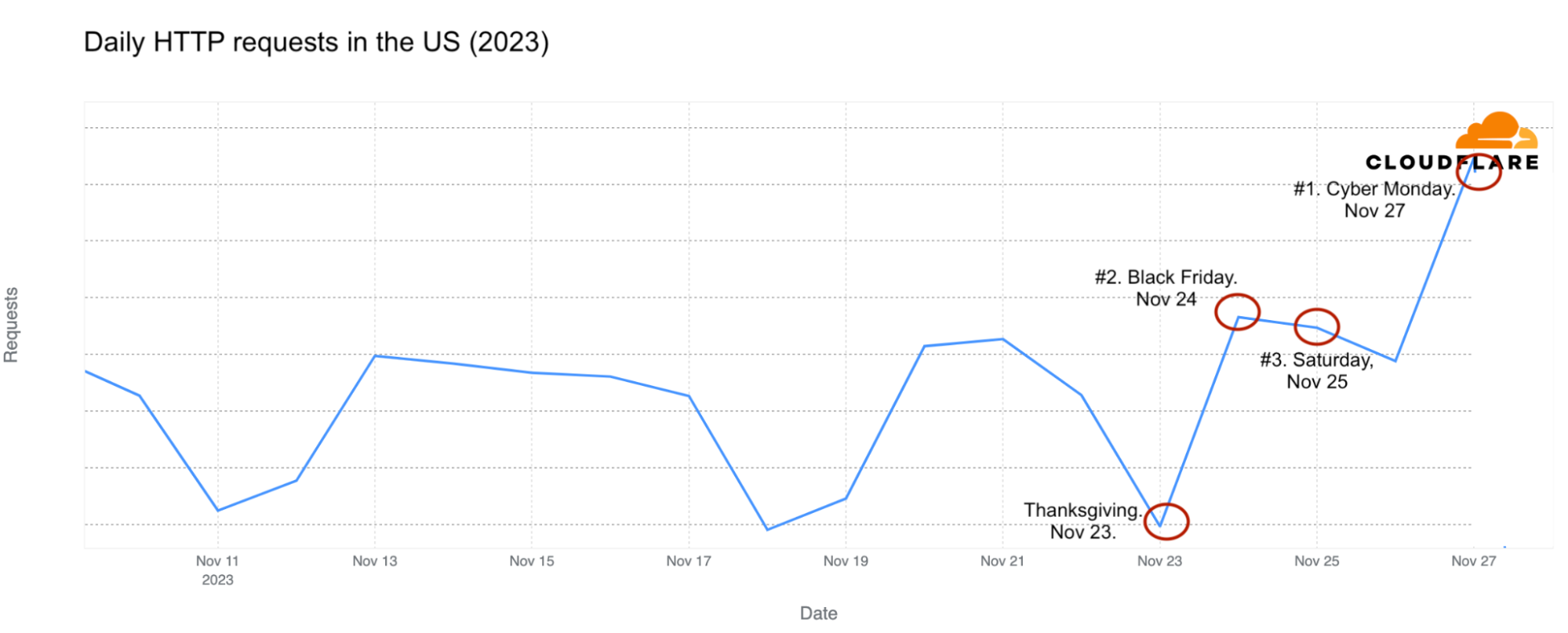
Additionally, most U.S. states show a similar trend, with Cyber Monday experiencing the most traffic, followed by Black Friday. However, Alaska is a notable exception, where the days with the highest Internet traffic were November 13 and 14, coinciding with a snow emergency that closed schools and roads.
States like Colorado, Hawaii, Idaho, New Mexico, and California also had Saturday, November 25, as their second busiest day, but Cyber Monday also “won” there.
Does the Black Friday week impact other countries?
Internationally, a trend of peak Internet traffic in November is observed in most countries, as highlighted in our previous 2022 Year in Review (stay tuned for our 2023 edition in the next few weeks). This trend is likely linked to colder weather in the Northern Hemisphere, where approximately 87% of the world's population resided in 2023, as well as holidays and shopping periods, among other factors.
Here's a table summarizing the November days with the most traffic, where the Black Friday week plays a significant role.
Most popular Internet traffic days
Countries like India, Japan, South Korea, Thailand, and Indonesia, though they show increased traffic during October and November compared to other months, do not exhibit an obvious increase in traffic during Black Friday week.
Singles' Day (November 11), a popular Asian shopping event, only features in the top three traffic days in Turkey. In China, October saw bigger traffic peaks than November. However, in November, both Black Friday and the following day (November 25) showed clear increases in traffic, similar to Singles' Day. In South Africa, Singles' Day and Black Friday were the busiest traffic days in November, even though October also had higher peaks.
Black Friday goes mobile, Cyber Monday goes desktop
We observed last week that during Thanksgiving Day, mobile use in US Internet traffic was higher than in the previous week. This trend was intensified on Black Friday, peaking at 55.3% of all traffic, surpassing the typical weekend, which usually sees a higher mobile usage percentage. However, on Cyber Monday, desktop use took the lead, with the percentage of mobile device traffic dropping to 47.6%, lower than the previous Monday.
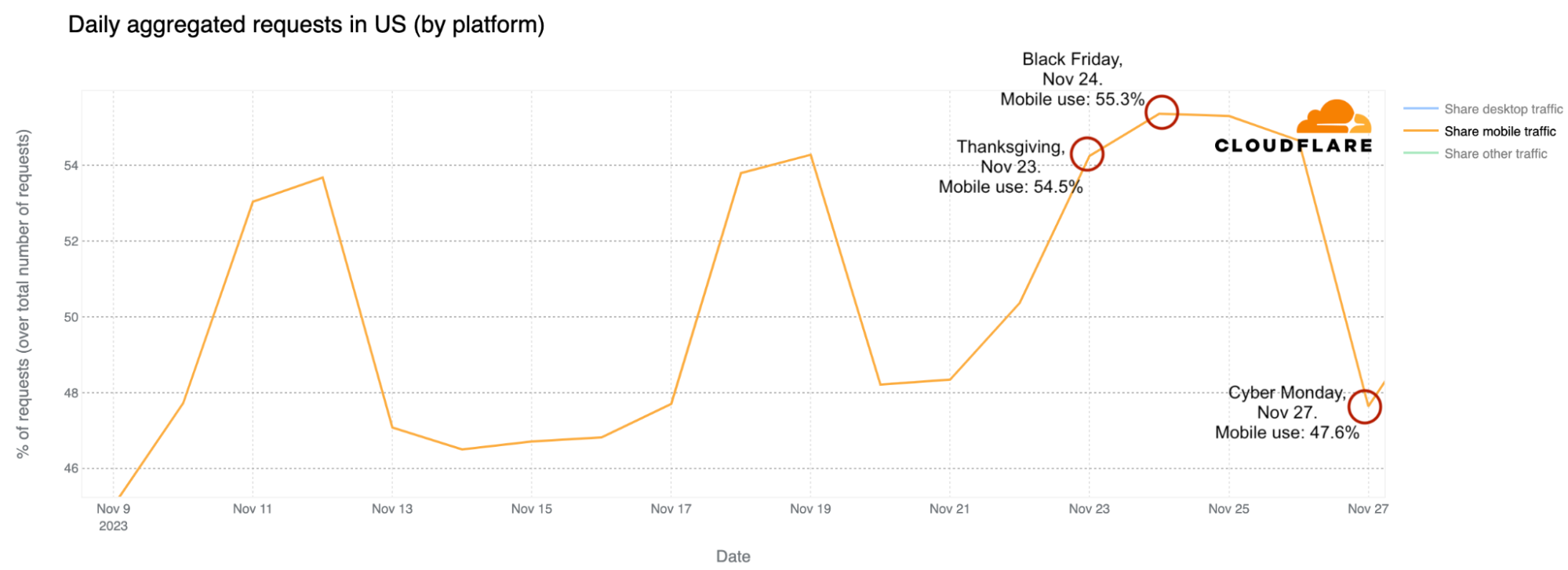
This trend seems to suggest that Black Friday shopping might involve more offline activities, with people in the US using their mobile devices more for Internet access on that day.
E-commerce DNS trends
Using aggregated data from our 1.1.1.1 resolver, we have a more focused, category-specific view of the DNS traffic growth to e-commerce sites. There's a general rising trend throughout November, very similar to what we observed in the Internet traffic section.
Looking more closely at the US aggregated e-commerce sites, it's evident that Cyber Monday and Black Friday, in that order, were the days with the most DNS traffic, with Saturday, November 25, ranking third on the podium — exactly mirroring the HTTP traffic pattern discussed earlier.
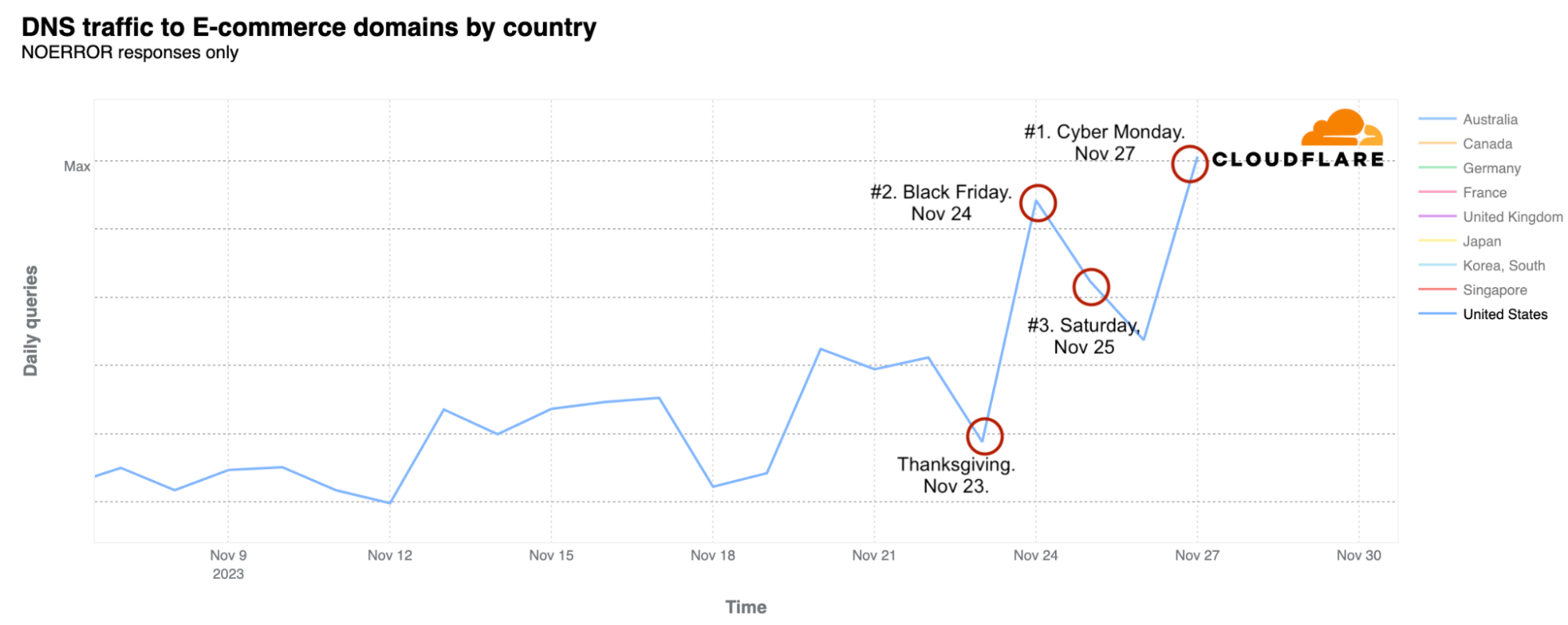
The peak hours of DNS traffic on Black Friday were around 16:00 and 17:00 UTC, which correspond to 12:00 and 13:00 EST and 09:00 and 10:00 PST. The same pattern was observed on Cyber Monday.
During Cyber Week (November 20 to 27), there was a 15% increase in DNS traffic compared with the previous week. A consistently high level of DNS traffic was maintained throughout Black Friday week, starting on Monday, November 20, with the sole exception being a noticeable drop on Thanksgiving Day — DNS traffic to e-commerce sites was 6% lower than the previous week on that day.
A glimpse into Europe’s e-commerce trends
The UK shows a very similar trend to the US in terms of Black Friday and Cyber Monday interest. However, in 2023, Black Friday and Cyber Monday are tied for the top spot, followed by Tuesday, November 21.
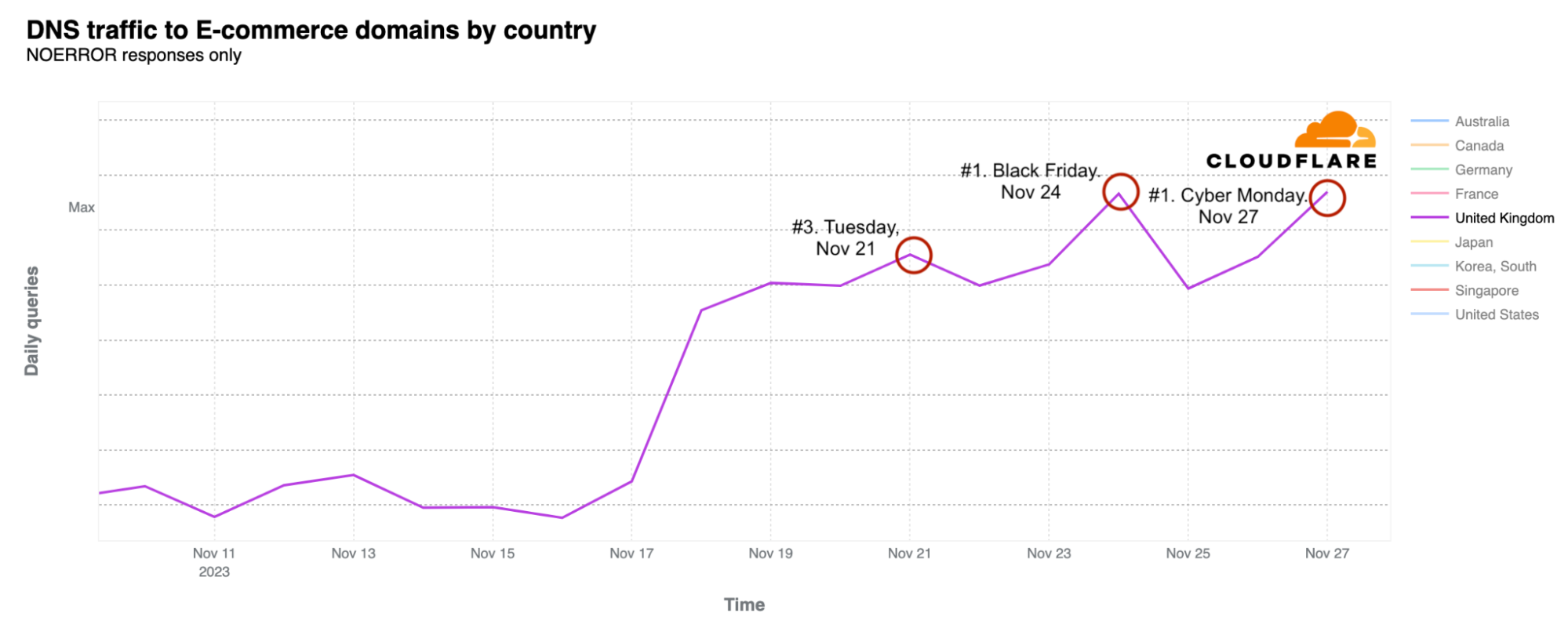
In Australia, Cyber Monday ranked as the most popular day for e-commerce DNS traffic, followed by Black Friday. Canada showed a similar pattern, with Black Friday being the most trafficked day, followed by Cyber Monday.
In Germany, Black Friday indisputably led in e-commerce DNS traffic, followed by the previous Friday, November 17, and then the Black Friday weekend. Cyber Monday did not make it to the top three in Germany.
In France, Black Friday was the most popular e-commerce day, followed by Saturday, November 18.
Electronics, fast fashion, and second-hand trends
Focusing on the US only again, electronics e-commerce sites experienced more DNS traffic on Black Friday than on Cyber Monday.
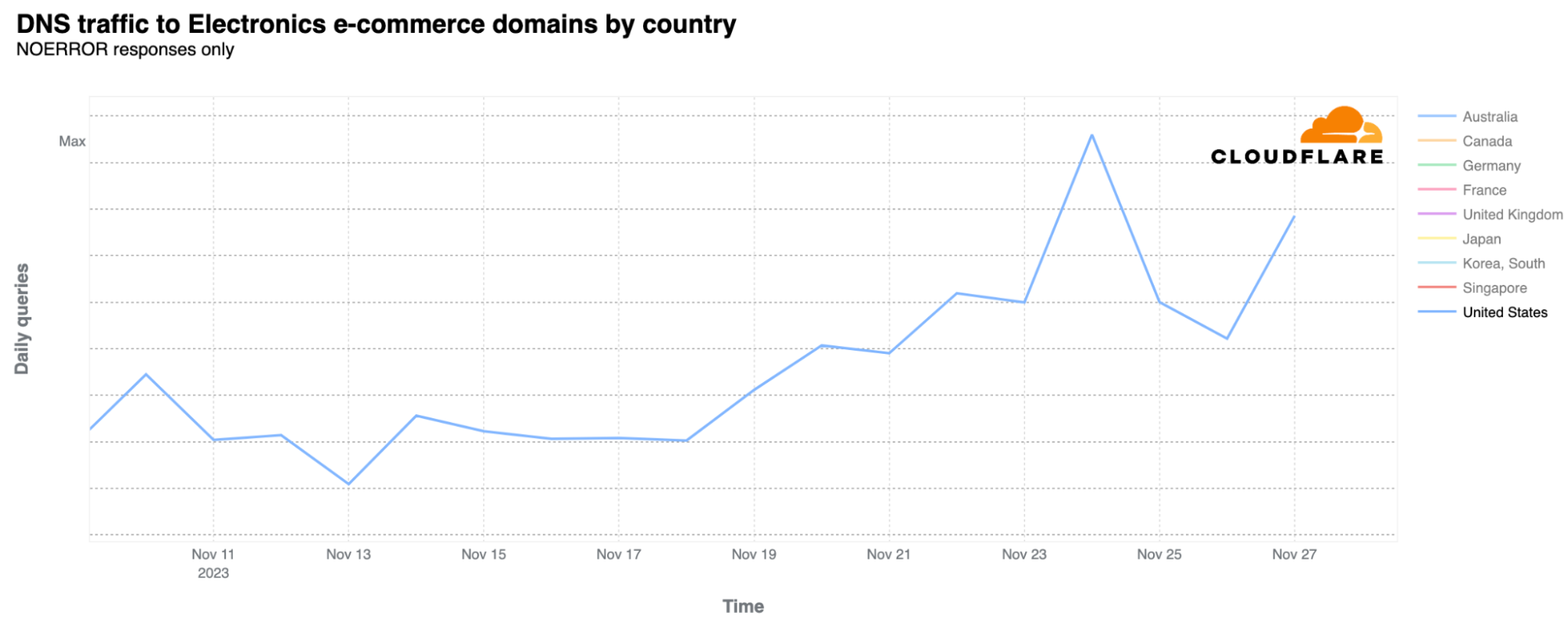
This trend was mirrored in the fast fashion category, with Black Friday clearly in the lead.
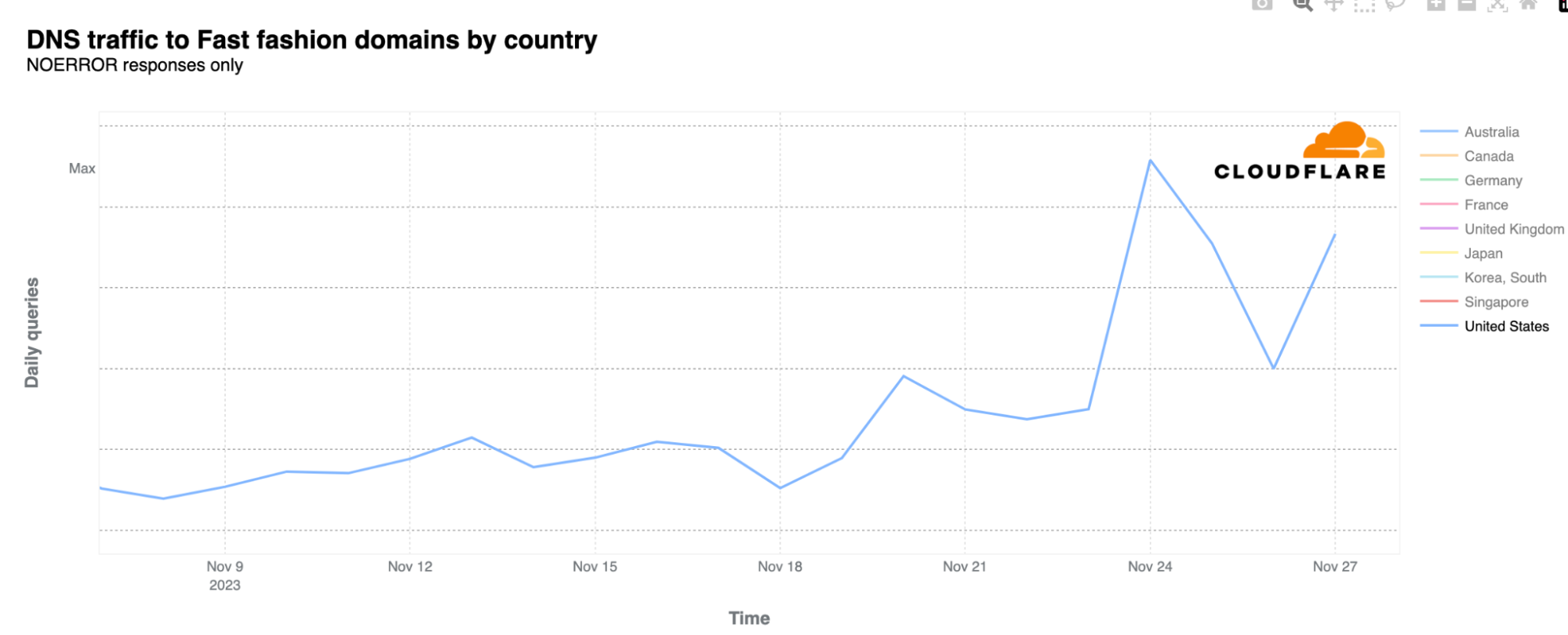
It's perhaps unsurprising that second-hand shopping sites in the US gained more momentum and DNS traffic in the preceding week (November 12-18) leading up to Black Friday. However, these sites then reached their peak on Cyber Monday.

How about cyber threats?
Regarding cyber threats, let's focus on DDoS (distributed denial-of-service) attacks, a popular method for disrupting Internet properties. Data from November 2023 shows that on Thanksgiving, DDoS attacks accounted for the lowest daily fraction of traffic volume observed in the month of November across the US. There were higher percentages of DDoS attacks in late August and September, associated with the HTTP/2 Zero-Day vulnerability, which led to record-breaking attacks.
The Black Friday week was not a peak period for DDoS attacks. The highest activity in November occurred earlier, mainly in the week of November 6-13.
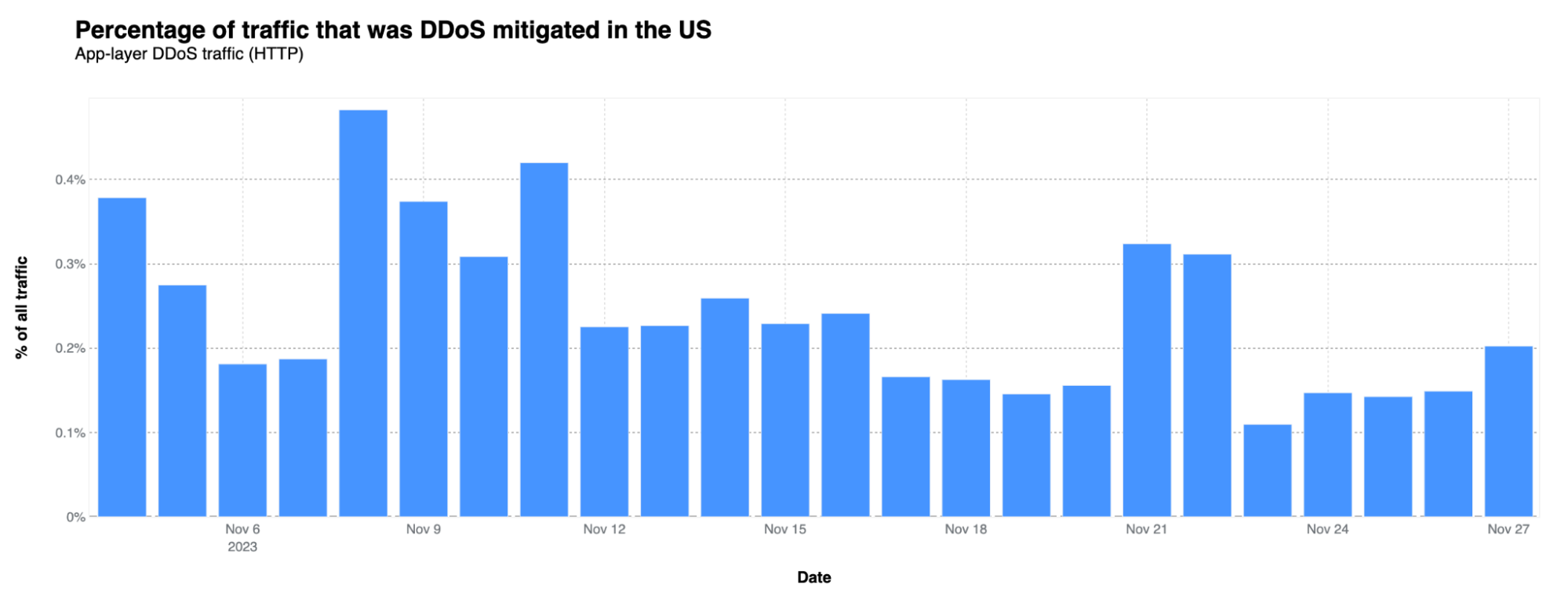
This pattern is consistent with 2022, where a higher percentage of DDoS attacks was observed before November 21.
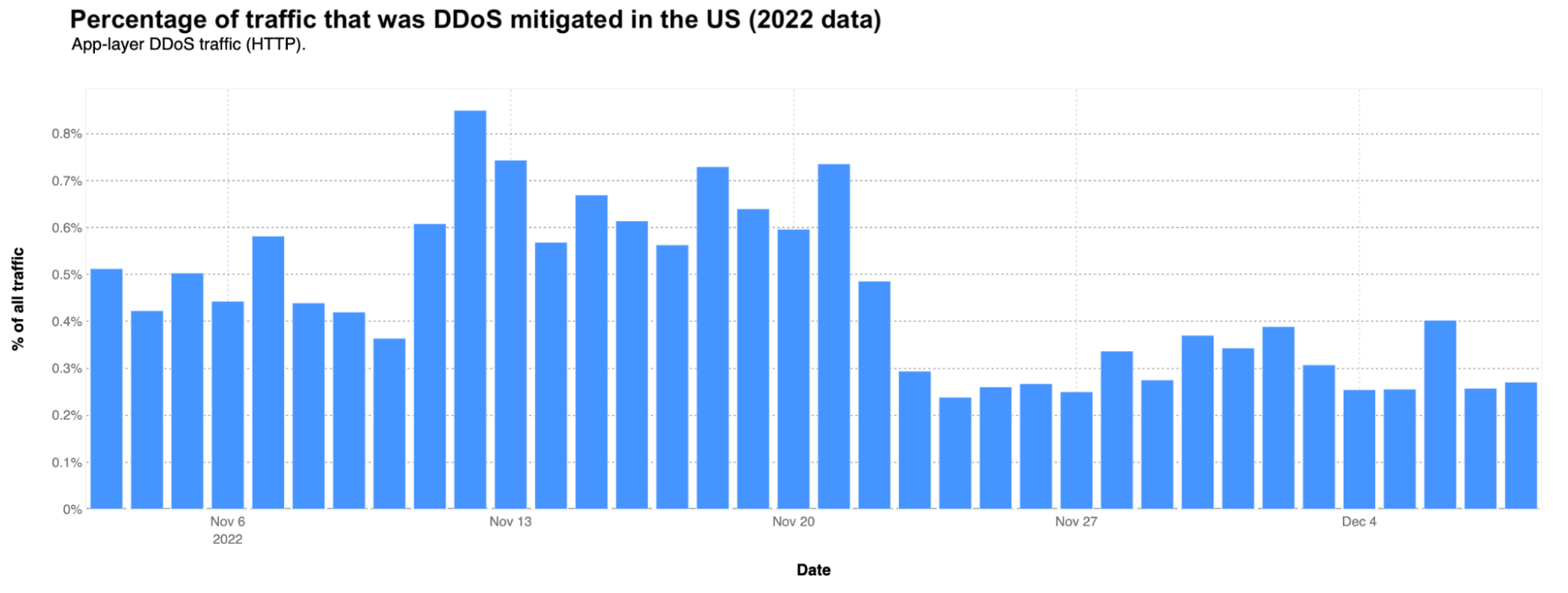
Going back to 2023, in terms of potential blocked attacks targeting the "Shopping & General Merchandise" industry, a similar pre-Black Friday week trend is evident. Here we’re including both DDoS and attacks blocked by the Managed Ruleset enforced by Cloudflare’s Web Application Firewall (WAF), and it’s a global perspective. The peak of 7.3 billion daily HTTP requests blocked by our WAF occurred during the weekend before Thanksgiving (November 18), coinciding with early Black Friday promotions.
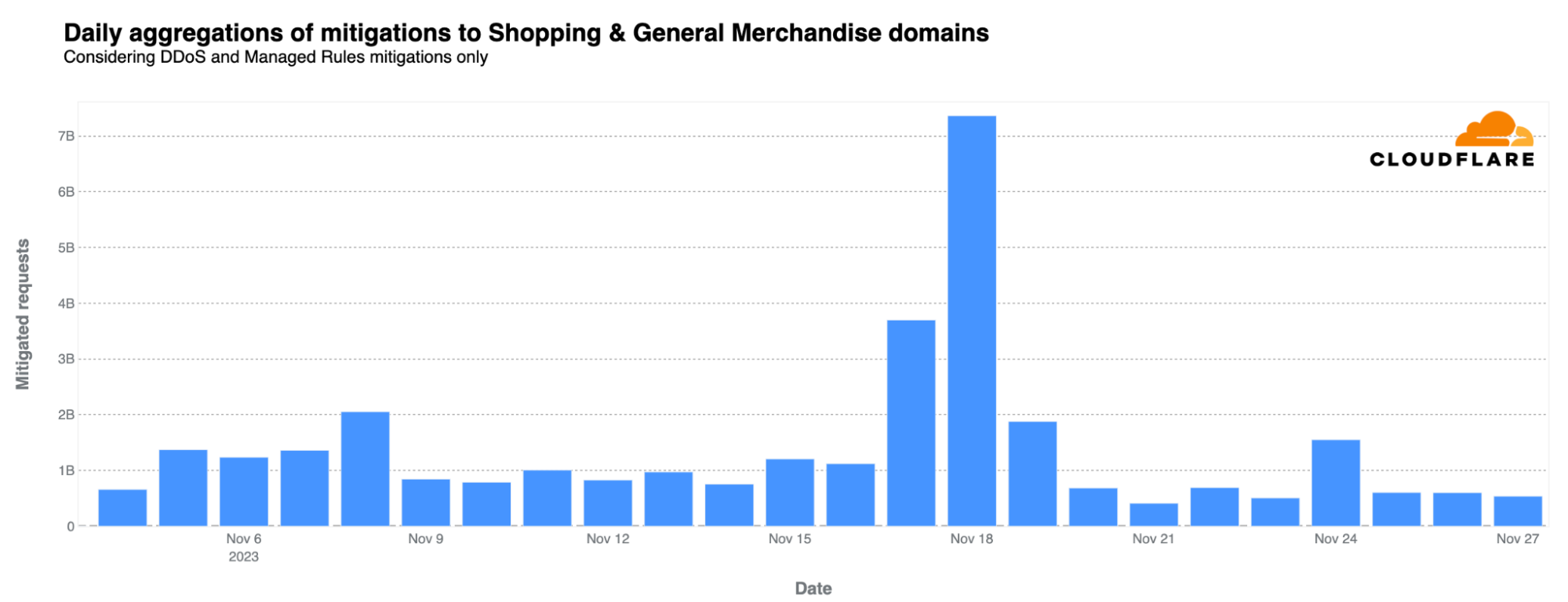
Conclusion
The trends in Internet traffic during events like Black Friday and Cyber Monday highlight a complex pattern of behavior globally and regionally. Cyber Monday leads the way in Internet traffic, closely followed by Black Friday. The trends in the US and UK are similar, but other countries like Germany and France show distinct patterns. The period before Black Friday also gained traction in terms of Internet and e-commerce activity in some countries.
The shift towards mobile usage on Black Friday and desktop dominance on Cyber Monday (in the US) suggests different consumer behaviors, with e-commerce sites experiencing significant DNS traffic increase during these peak shopping periods.
In terms of cybersecurity, while attacks are constant, we observed a lower incidence of DDoS attacks during the Black Friday week in 2023, but there was a clear increase in the two weeks leading up to the most shopping-intense period.
And finally — don't forget, you can check Cloudflare Radar to track global and country-specific Internet traffic trends.
Happy Holidays from everyone at Cloudflare!

